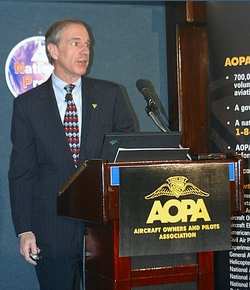 AOPA has told the FAA that its draft
strategic plan, Flight Plan for 2004-2008,
"falls short of its mark and insisted the agency adequately address
the needs of general aviation."
AOPA has told the FAA that its draft
strategic plan, Flight Plan for 2004-2008,
"falls short of its mark and insisted the agency adequately address
the needs of general aviation."
In its most glaring omission, the FAA's draft plan does not deal
with the effects of aviation security requirements on GA traffic,
which accounts for most of the flight hours in this country. In a
letter and accompanying comments to FAA Administrator Marion
Blakey, AOPA President Phil Boyer stressed that the FAA must
develop a new strategy that mitigates the impact of
security-related flight restrictions. Those restrictions
effectively constrain GA capacity, causing congestion and delays
around the country, especially in the area of the
Baltimore-Washington Air Defense Identification Zone (ADIZ) and the
Presidential movement temporary flight restrictions (TFRs).
"The FAA should not ignore its responsibility for an efficient
air traffic control system that should serve the needs of the
aviation users as it implements security driven restrictions,"
Boyer wrote. "As the FAA notes in its introduction of the draft
plan, '...the challenges facing aviation demand nothing less than a
transformation of the system itself.' We couldn't agree more." The
letter calls on the FAA to establish measurable goals tied to the
FAA's budget to address security-related capacity constraints and
improve GA access to airspace.
AOPA also voiced concern about a new safety improvement
initiative, known as the FAA/Industry Training Standards program,
or FITS.
 FITS is an attempt by the FAA to
recognize that aviation technology, in both airframes and
especially avionics, is evolving so rapidly that the old training
regimen that has stood for decades may no longer be enough. The
program is a non-regulatory voluntary "add-on" that would train
pilots in the use of specific equipment or aircraft.
FITS is an attempt by the FAA to
recognize that aviation technology, in both airframes and
especially avionics, is evolving so rapidly that the old training
regimen that has stood for decades may no longer be enough. The
program is a non-regulatory voluntary "add-on" that would train
pilots in the use of specific equipment or aircraft.
AOPA has no problem with the goals of the program, but is
worried about implementation issues. For one thing, FITS may well
lead to changes in the Practical Test Standards, which the FAA can
make without public input. Further, AOPA is concerned that aircraft
manufacturers and insurers may make passing a FITS program
mandatory for buying an aircraft or receiving a policy. Such a
requirement by industry would make the initiative a de facto
regulation and, were industry to charge for the training, turn the
initiative into a profit center.
In his letter, Boyer also told Blakey that while AOPA respects
the FAA's efforts to reassert U.S. leadership in the international
aviation community, all-out efforts to "harmonize" U.S. regulations
with other nations' could hurt general aviation in America, where
GA is more vibrant and of greater utility than anywhere else in the
world.
Boyer warned, "If the FAA does not revise its objectives in the
International Leadership section to include protection of domestic
general aviation, it will end up pursuing global regulatory and
policy-making initiatives that are not in 'America's best
interest.'"
"I ask that you take AOPA's concerns to heart and incorporate
our recommendations to address the areas affecting general
aviation," he concluded.
 Aero-TV: DeltaHawks Diesel Power Steps Into the Spotlight
Aero-TV: DeltaHawks Diesel Power Steps Into the Spotlight NTSB Prelim: Mooney Aircraft Corp. M20K
NTSB Prelim: Mooney Aircraft Corp. M20K ANN FAQ: Turn On Post Notifications
ANN FAQ: Turn On Post Notifications ANN's Daily Aero-Linx (12.20.25)
ANN's Daily Aero-Linx (12.20.25) Aero-News: Quote of the Day (12.20.25)
Aero-News: Quote of the Day (12.20.25)




